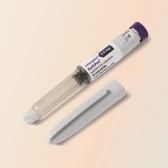Every medication has some side effects, and Mounjaro is no different. Because it works directly on your gut hormones to help regulate blood sugar and appetite, it can also affect digestion, especially in the first few weeks.
The good news? These symptoms are usually short-lived and manageable with a few small lifestyle tweaks. As your body adjusts and your dose stabilises, most people find their digestion settles back to normal. In this guide, we cover why these effects happen, how long they last, what helps, and when to get medical help.
Why does Mounjaro cause digestive side effects?
Mounjaro (tirzepatide) activates two gut-hormone receptors, GIP and GLP-1. This combination slows how quickly your stomach empties, reduces hunger, and changes gut motility (the speed and rhythm of movement through your digestive tract).
When food moves more slowly, it can lead to diarrhoea, constipation, stomach pain, or heartburn, especially in the early stages or after a dose increase. This is why treatment usually starts on a low dose and increases gradually so your gut can adapt.
Your personal “triggers” can change when you first start or when the dose steps up. Keeping a brief food and symptom diary for 1–2 weeks helps you spot patterns and tweak meals accordingly.
If you already experience heartburn, IBS, or constipation, Mounjaro can temporarily make those symptoms more noticeable until your body adjusts.
Side effects support at Voy
"If you're using Voy and you experience any side effects, rest assured that our expert clinicians are just a message or phone call away. They can adjust your dose, prescribe medication to ease your symptoms, or simply offer reassurance.
Everyone responds differently to weight loss treatment and we'll help you find what feels right for you."

Diarrhoea on Mounjaro
Why does Mounjaro cause diarrhoea?
Because Mounjaro slows stomach emptying and changes how quickly food moves through your gut, some people get loose stools or diarrhoea as the body adjusts. In weight-management trials, diarrhoea affected about 18–23% of people depending on the dose.
How long does diarrhoea last?
Most people notice symptoms within a few days of starting or after a dose increase. Diarrhoea typically improves over several days and usually resolves within one to two weeks as your body adapts. For a minority, mild loose stools can linger a little longer but often resolve with small lifestyle changes.
How to treat diarrhoea
- Hydrate well with water or an oral rehydration sachets
- Small, frequent meals instead of large portions
- BRAT-style choices when needed: bananas, rice, apple sauce, toast, plain crackers
- Avoid triggers: greasy or high-fat foods, very spicy meals, alcohol, caffeine, fizzy drinks
- Reduce fibre temporarily, then reintroduce gentle soluble fibre (oats, psyllium) as symptoms ease
- Short-term anti-diarrhoeal such as loperamide may help; check with a pharmacist first
- Consider reducing your dose or delaying next dose increase
Constipation on Mounjaro
Can Mounjaro cause constipation?
Yes. While diarrhoea is common, Mounjaro can also slow bowel movement, leading to constipation. In clinical trials, about 11–17% of people reported constipation. This tends to improve as your body adjusts to the slower digestion process.
How to treat constipation
- Drink more fluids: aim for about 2 litres of water a day.
- Add gentle fibre gradually: oats, psyllium (ispaghula husk), or ground flaxseed. A fibre supplement such as Fybogel can help if food alone isn’t enough — speak to a pharmacist first.
- Include natural laxative foods: prunes, kiwi, and pears.
- Keep moving: walking, light jogging or yoga can stimulate the bowels.
- Short-term laxatives: an osmotic laxative or a stool softener may be used short term. Check with a pharmacist or prescriber for the best option for you.
- If your symptoms began after a recent dose increase, consider a slower titration after discussing it with your provider.
Stomach pain on Mounjaro
It’s common to notice mild stomach discomfort or cramping when starting Mounjaro, particularly in the first few weeks or after a dose increase. In studies, abdominal pain was reported by 9–10% of people taking tirzepatide at 5–15 mg.
This discomfort often comes from temporary stretching, changes in movement through the gut, trapped gas, or mild irritation of the stomach lining. These effects are usually short-lived and improve as your body adjusts.
Stomach pain relief
- Eat smaller portions and take your time when eating.
- Opt for lighter meals and avoid heavy, high-fat or creamy dishes.
- Limit triggers like caffeine, alcohol and fizzy drinks
- Spot your personal triggers with a brief food and symptom diary and avoid them for a week or two
- Stay upright after meals for at least an hour or two
- Try ginger or peppermint tea to ease indigestion
- Short-term antacids may ease upper-stomach burn or reflux; check with a pharmacist if you need something stronger
Heartburn on Mounjaro
Does Mounjaro cause heartburn?
By slowing how quickly food leaves the stomach, Mounjaro (tirzepatide) can increase the likelihood of acid reflux and heartburn. This delay in gastric emptying can cause food and stomach acid to move back up towards the oesophagus, creating a burning or uncomfortable sensation in the chest.
Some people also notice indigestion, bloating, or burping alongside heartburn. In clinical trials, these symptoms were reported in around 4–10% of people taking tirzepatide.
Managing heartburn
- Eat more slowly and avoid lying down straight after meals.
- Reduce portion size and choose smaller, lighter meals.
- Limit trigger foods such as citrus, tomatoes, chocolate, caffeine, alcohol, and very spicy or high-fat meals.
- Leave 3–4 hours between your last meal and bedtime to allow your stomach to empty before sleep.
- Raise the head of your bed by 15–20 cm if symptoms appear at night.
- Try an over-the-counter remedy such as Gaviscon or Pepto-Bismol, but check with a pharmacist first.
What foods help or worsen digestive symptoms
Start here, then fine-tune to what you tolerate best. Tailor it to your symptom: for diarrhoea, go lower fibre until symptoms settle, then reintroduce gentle fibre slowly; for constipation, add fibre gradually to help things move more regularly.
Worsening Foods / Triggers
- Fried, greasy, spicy foods
- High-fat and creamy meals
- Caffeine, alcohol, carbonated drinks
- High insoluble fibre (raw veggies, seeds)
- Raw legumes, cruciferous raw cabbage
Typically Safe Choices
- Plain rice, boiled potatoes
- Steamed vegetables, lean chicken, fish
- Water, herbal tea, electrolyte fluids
- Cooked vegetables, peeled fruits
- Prunes, peeled apples, cooked oats
Everyone’s triggers are different and they can change when you increase the dose or switch medicines. Something that wasn’t a trigger on a lower dose may become one after a dose increase or when switching from Mounjaro to Wegovy weight loss injections.
And if you are dealing with sulphur burps, try reducing sulphur-rich foods for a week or two. That includes eggs, some meats and fish, and cruciferous vegetables like broccoli and cabbage. You can find more tips in Sulphur burps on Mounjaro: Learn everything you need to know.
When to see a doctor
Digestive side effects on Mounjaro are common and usually ease on their own. The tips above often help. If you’ve tried those changes and your symptoms keep going, get worse, or new ones appear, it’s a good idea to check in so your treatment plan can be reviewed.
Seek urgent medical help if you notice:
- Severe or worsening abdominal pain
- Pain that spreads to your back
- Fever or chills
- Blood in your stool or black, tar-like stools
- Persistent vomiting
- Signs of dehydration such as lightheadedness, very dark or low urine output, or extreme thirst
- Yellowing of the skin or eyes (jaundice)
Need support? With Voy, you can speak to a clinician within minutes. Call our hotline or message us through the in-app chat and we’ll help you figure out the next best step.











